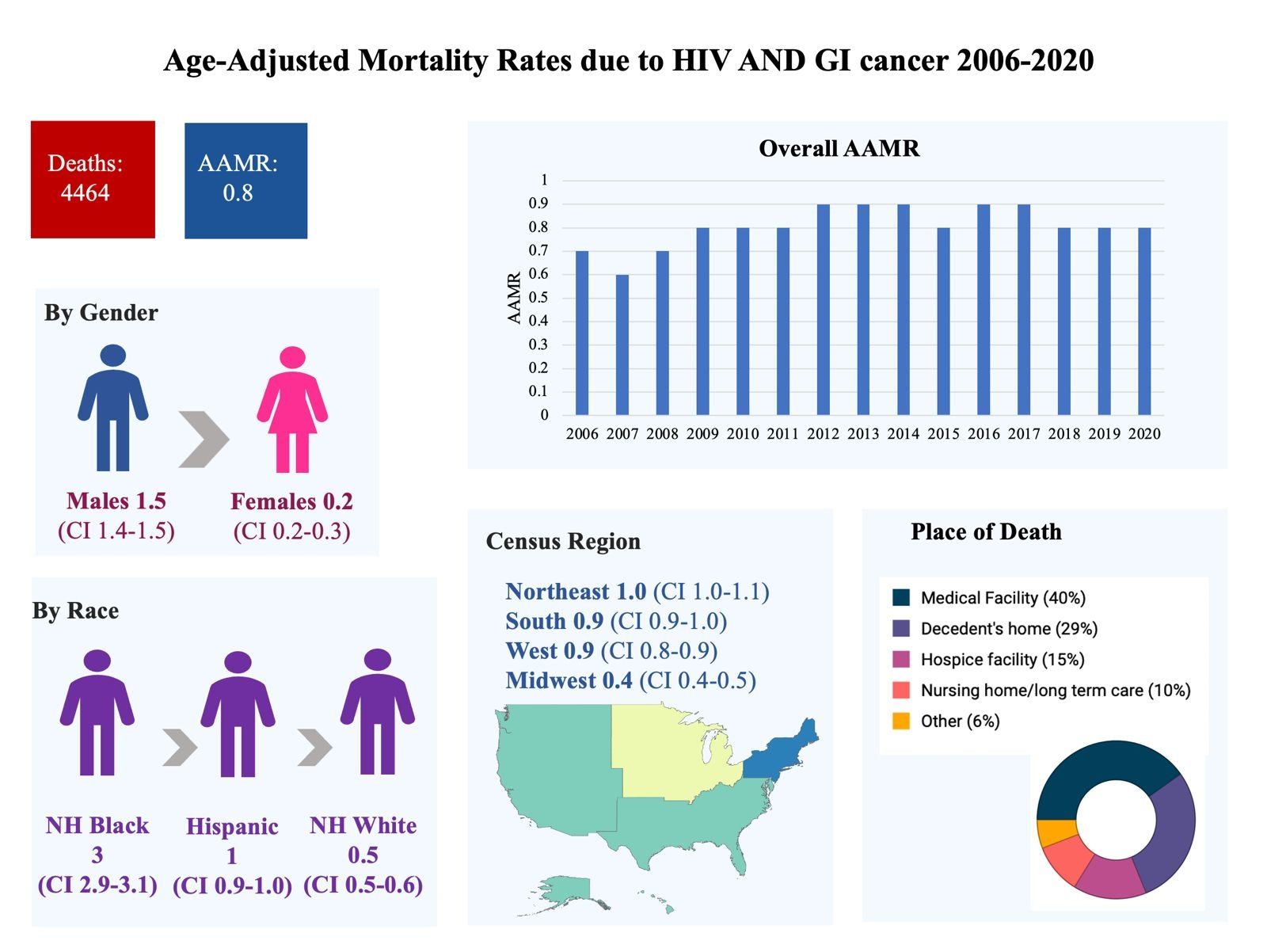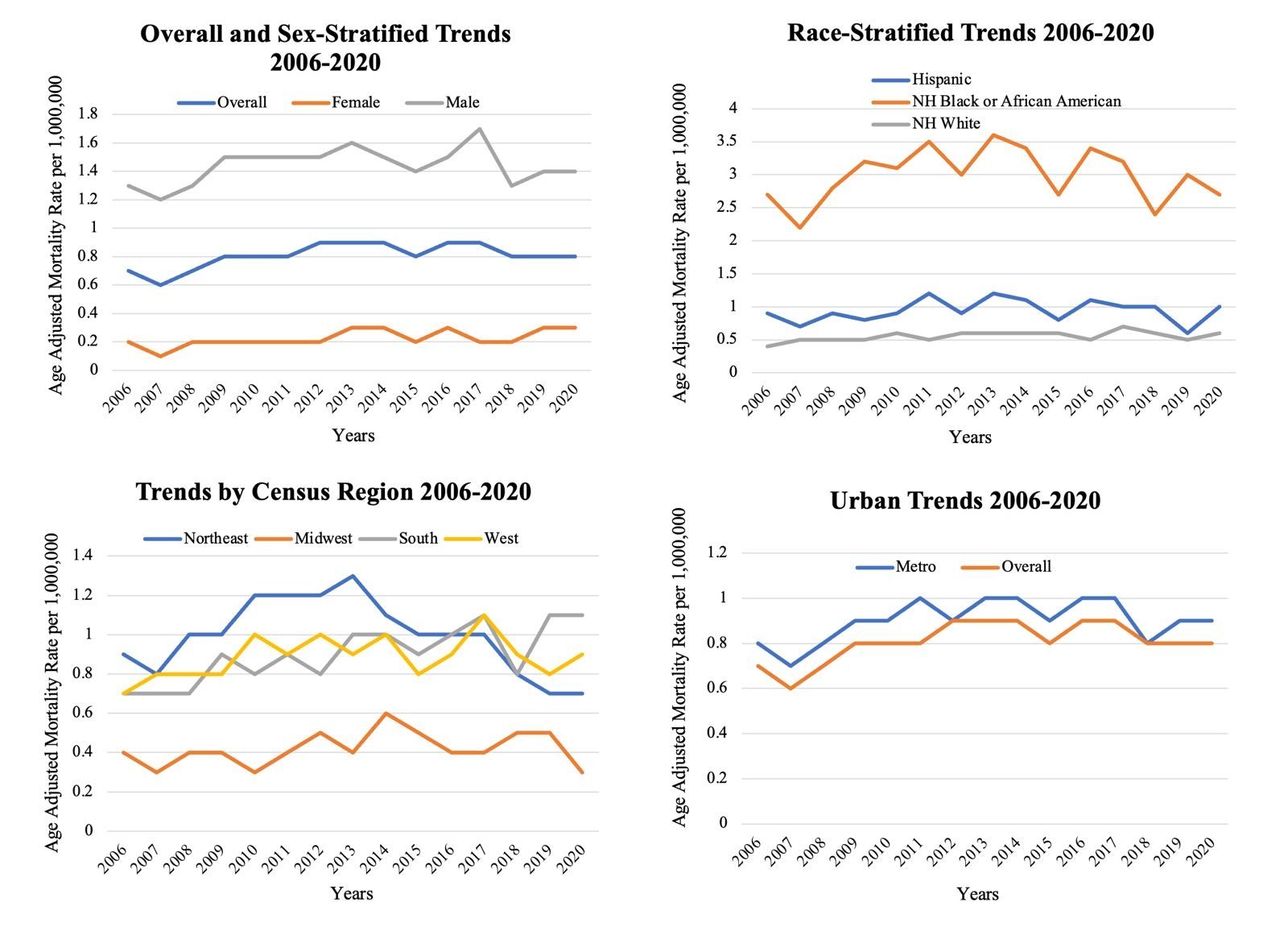Sunday Poster Session
Category: Infections and Microbiome
P1289 - Persistent Racial Disparities in Mortality Due to HIV-Related Gastrointestinal Cancers: A Nationwide Analysis
Sunday, October 26, 2025
3:30 PM - 7:00 PM PDT
Location: Exhibit Hall

Zubia Zaman, MBBS (she/her/hers)
Dow Medical College, PA
Presenting Author(s)
Zubia Zaman, MBBS1, Syed Hamaad Rahman, DO2
1Dow Medical College, Karachi, Sindh, Pakistan; 2Methodist Dallas Medical Center, Dallas, TX
Introduction: With the advent of antiretroviral therapy (ART), mortality rates due to HIV have declined in recent years. However, individuals living with HIV are now at an increased risk of non-HIV comorbidities, including non-AIDS-defining malignancies. Studies have shown an increased incidence of esophageal, gastric, pancreatic, hepatocellular, and colorectal carcinoma, among patients with HIV. Since temporal and demographic patterns of gastrointestinal cancers-associated liver mortality in the U.S. are not well known, we leveraged a large national database to analyze mortality trends from 2006 to 2020.
Methods: Mortality data from the CDC WONDER database were analyzed for HIV and Gastrointestinal (GI) cancers from 2006 to 2020. Age-adjusted mortality rates (AAMRs) were calculated per 1,000,000 individuals. Annual percent change (APC) and average annual percent change (AAPC) were computed using Joinpoint regression. Trends were stratified by year, sex, race/ethnicity, urbanization status, and geographic region.
Results: From 2006 to 2020, there were 4,464 HIV-associated GI cancer deaths in the United States with an overall AAMR of 0.8. Males had a higher mortality rate than females (overall AAMR Males: 1.5; Females :0.2). AAMRs were substantially higher among the non-Hispanic (NH) Black population (overall AAMR: 3.0), than Hispanics (overall AAMR: 1) and NH Whites (overall AAMR: 0.5). Hispanics had the highest increase in mortality rate (AAPC Hispanics: 1.01; NH Blacks: 0.02). Regionally, Northeast had the highest mortality rates (AAMR Northeast: 1.0; South: 0.9; West: 0.9; Midwest: 0.4). However, Northeast experienced a decline in mortality rate from 0.9 in 2006 to 0.7 in 2020 (AAPC 2006-2020 Northeast: -1.74). South had the highest increase in AAMRs (AAPC 2006-2020 South: 2.95, Midwest: 1.66, West :1.03). The District of Columbia reported the highest mortality rate (overall AAMR: 8.7). Mortality rates in urban areas increased with an overall AAMR: 0.9 and AAPC: 0.91. Visual trends are illustrated in Figure 1.
Discussion: Mortality due to HIV-associated GI cancer has increased from 2006 to 2020. The highest AAMRs were observed among NH Black individuals and men, and among individuals living in the Northeast. These disparities warrant targeted policies to improve access to treatment and better screening to reduce mortality rates.

Figure: Figure 1

Figure: Age-Adjusted Mortality Rates due to HIV AND GI cancer from 2006-2020
Disclosures:
Zubia Zaman indicated no relevant financial relationships.
Syed Hamaad Rahman indicated no relevant financial relationships.
Zubia Zaman, MBBS1, Syed Hamaad Rahman, DO2. P1289 - Persistent Racial Disparities in Mortality Due to HIV-Related Gastrointestinal Cancers: A Nationwide Analysis, ACG 2025 Annual Scientific Meeting Abstracts. Phoenix, AZ: American College of Gastroenterology.
1Dow Medical College, Karachi, Sindh, Pakistan; 2Methodist Dallas Medical Center, Dallas, TX
Introduction: With the advent of antiretroviral therapy (ART), mortality rates due to HIV have declined in recent years. However, individuals living with HIV are now at an increased risk of non-HIV comorbidities, including non-AIDS-defining malignancies. Studies have shown an increased incidence of esophageal, gastric, pancreatic, hepatocellular, and colorectal carcinoma, among patients with HIV. Since temporal and demographic patterns of gastrointestinal cancers-associated liver mortality in the U.S. are not well known, we leveraged a large national database to analyze mortality trends from 2006 to 2020.
Methods: Mortality data from the CDC WONDER database were analyzed for HIV and Gastrointestinal (GI) cancers from 2006 to 2020. Age-adjusted mortality rates (AAMRs) were calculated per 1,000,000 individuals. Annual percent change (APC) and average annual percent change (AAPC) were computed using Joinpoint regression. Trends were stratified by year, sex, race/ethnicity, urbanization status, and geographic region.
Results: From 2006 to 2020, there were 4,464 HIV-associated GI cancer deaths in the United States with an overall AAMR of 0.8. Males had a higher mortality rate than females (overall AAMR Males: 1.5; Females :0.2). AAMRs were substantially higher among the non-Hispanic (NH) Black population (overall AAMR: 3.0), than Hispanics (overall AAMR: 1) and NH Whites (overall AAMR: 0.5). Hispanics had the highest increase in mortality rate (AAPC Hispanics: 1.01; NH Blacks: 0.02). Regionally, Northeast had the highest mortality rates (AAMR Northeast: 1.0; South: 0.9; West: 0.9; Midwest: 0.4). However, Northeast experienced a decline in mortality rate from 0.9 in 2006 to 0.7 in 2020 (AAPC 2006-2020 Northeast: -1.74). South had the highest increase in AAMRs (AAPC 2006-2020 South: 2.95, Midwest: 1.66, West :1.03). The District of Columbia reported the highest mortality rate (overall AAMR: 8.7). Mortality rates in urban areas increased with an overall AAMR: 0.9 and AAPC: 0.91. Visual trends are illustrated in Figure 1.
Discussion: Mortality due to HIV-associated GI cancer has increased from 2006 to 2020. The highest AAMRs were observed among NH Black individuals and men, and among individuals living in the Northeast. These disparities warrant targeted policies to improve access to treatment and better screening to reduce mortality rates.

Figure: Figure 1

Figure: Age-Adjusted Mortality Rates due to HIV AND GI cancer from 2006-2020
Disclosures:
Zubia Zaman indicated no relevant financial relationships.
Syed Hamaad Rahman indicated no relevant financial relationships.
Zubia Zaman, MBBS1, Syed Hamaad Rahman, DO2. P1289 - Persistent Racial Disparities in Mortality Due to HIV-Related Gastrointestinal Cancers: A Nationwide Analysis, ACG 2025 Annual Scientific Meeting Abstracts. Phoenix, AZ: American College of Gastroenterology.


